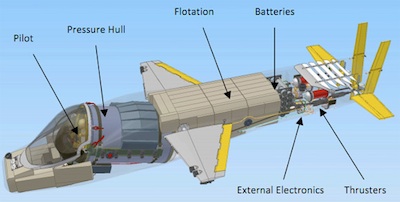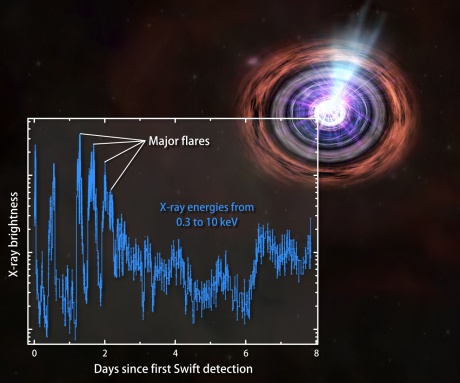 This is a big week for science, with a giant new rocket unveiled by SpaceX, Richard Branson going from Galactic to Oceanic with a cool one-man submarine, FermiLab physicists discovering a new particle (or maybe a new ‘force’ or something they aren’t sure), and NASA telescopes spotting a star being literally torn apart by a giant black hole. We have all that plus a do-it-yourself cannon, and the birthday of the Internet (maybe).
This is a big week for science, with a giant new rocket unveiled by SpaceX, Richard Branson going from Galactic to Oceanic with a cool one-man submarine, FermiLab physicists discovering a new particle (or maybe a new ‘force’ or something they aren’t sure), and NASA telescopes spotting a star being literally torn apart by a giant black hole. We have all that plus a do-it-yourself cannon, and the birthday of the Internet (maybe).
SpaceX Unveils Plans for World’s Most Powerful Rocket
Private spaceship maker SpaceX has announced plans to construct a new heavy-lift rocket that will be the most powerful rocket currently in operation and the most powerful commercial rocket ever built. The new unmanned rocket, Falcon Heavy, will be able to carry twice the payload of the space shuttle at around one-tenth of the cost ($1,000 per pound), setting a new record for the cost per pound to orbit. The first launch of Falcon Heavy could come as early as 2013.
Learn more at SpaceX.
Richard Branson Announces Virgin Oceanic + Plans for One-Man Submarine
Sir Richard Branson, owner of the Virgin conglomerate, has unveiled plans for a new venture called Virgin Oceanic. Similar to the company’s space exploration initiative, Virgin Galactic, Virgin Oceanic will push human boundaries into the final frontiers of exploration. The project will develop a single-man “flying” submarine described as, “the only piloted craft in existence that has ‘full ocean depth’ capability”. Virgin Oceanic explains: “The one person sub has an operating depth of 37,000ft (7 miles) and is capable of operating for 24hrs unaided. Once fully descended, the submarine’s hydroplanes (the equivalent of wings for submarines) and thrusters will allow it to ‘fly’ up to 10km over the ocean floor whilst collecting video and data, something submersibles could only dream of.”

Visit msnbc.com for breaking news, world news, and news about the economy
MSNBC Clip
Virgin Oceanic promo video
New Particle or ‘new force’ discovered – or not?
Not willing to let CERN and the Large Hadron Collider in Switzerland grab all the headlines, this week FermiLab in Illinois announced their old Tevatron still has some tricks up its sleeve with the possible discovery of a new subatomic particle or maybe even a "new force". Fermilab physicist Christopher Hill told the New York Times “nobody knows what this is…If it is real, it would be the most significant discovery in physics in half a century.” The discovery of this "bump" has the physics community abuzz this week, with some skepticism also arising, astrophysicist Michael S. Turner tells LiveScience that the discovery could "completely transform high-energy physics, and cosmology as well, as the two fields are joined at the hip, But there is one big IF — if it holds up and
is not explained by standard model physics." The challenge for the physics community now is to replicate the result, possibly at the bigger LHC, with CERN’s Gavin Salam adding this note of caution “over the past decade there have been a number of particle-physics anomalies whose statistical significance was similar to this one, yet which, on accumulation of new data and subsequent reanalysis, turned out merely to be due to fluctuations of the data or incomplete estimates of the sources of background contamination.”

The bump heard round the world of physics
NASA Spots Star Torn Apart By Giant Black Hole
A collection of NASA telescopes (Swift, Hubble Space Telescope and Chandra X-ray Observatory ) observed an unprecedented stellar explosion this week. No it wasn’t the Hobus supernova which Spock turned into a giant black hole with Red Matter, but it was close. According to astronomers the unusual blast likely arose when a star wandered too close to its galaxy’s central black hole. Gravitational forces then literally tore the star apart with the spinning black hole creating an outflowing jet. The star was discovered in the constellation Draco and is now cataloged as gamma-ray burst (GRB) 110328A (they really need to jazz up those names). The location of the burst has been pinpointed to the center of a galaxy 3.8 billion light-years away. More details and images available at NASA.gov.

Swift Telescope observing X-Ray flares from
GRB 110328A
Gadget of the Week: DIY Gorn Canon
Captain Kirk had to rely on his own resourcefulness in a sticky situation (not to mention his dumb luck that everything he’d need would be laying around on some desert planet…) to defeat the Gorn captain. But, thanks to this video by HouseholdHacker, you can plan ahead and make your own Gorn canon-esque tennis ball shooter from a few household items! (via CBS News Tech Talk)
Video of the week: Happy Birthday To The Internet – or is it?
Is the Internet 42 years old? On April 7th 1969 an engineer drafted the first Request for Comment document for APRAnet, the precursor to the Internet. Tony Long of Wired argues this represents the “symbolic birth date of the net because the RFC memoranda contain research, proposals and methodologies applicable to internet technology.” However not everyone agrees, as Yahoo points out there are other dates that might count as day one for the Internet. G4’s Attack of the Show decided to get to the heart of the controversy.
Science Bytes
Not enough science for you? Here’s a warp-speed look at some more science tid-bits that are worth a peek.
- New theory from Cassini team "Titan shaped by weather, not volcanoes"
- Private company MoonEx is planning mission to moon to search for minerals worth mining
- NASA is close to decision as they evaluate landing spots for next Mars robot mission

Hey that star met the same fate as Nero’s ship when it ventured to close to a black hole. Which begs the question, how did Nero and Spock navigate the black hole the frist time without being ripped apart?
That’s a really cool mini-sub. What exactly keeps it from being crushed? 7 miles?
1 – Some things are never meant to be asked. Especially if you’re talking about a movie that’s grossed close to half-a-billion dollars.
# 1
structual integrity fields and deflector screens. Preserve the ship from any exterior forces. Bad thing when the black hole is IN your ship as was the case with Nero’s ship at the end.
#3
But how, pray tell, does a structural integrity field work? Is it a magnet? Is it radiation? Is it the space fairy? Lolol.
I’m excited about the Falcon 9 Heavy… a little too excited for my own good… how many times have I gotten myself convinced that a new spacecraft was going to revolutionize everything, and finally get us out of the human-spaceflight slump we’ve had to live with for 20 or so years? I’ve had to deal with being crestfallen about the x-33/VentureStar (that was the worst), and several others, too. The Falcon 9 Heavy looks like it actually stands a chance of being a success, but until that rocket is man-rated and starts to take astronauts up to the ISS, I will try to hold back my enthusiasm.
Shuttle is retiring! Scary! I wish the Europeans would just get Ariane man-rated….
C’mon, structural integrity fields are made of pixie dust. Everyone knows that.
Am looking forward to the inevitable Harry Ballz remark on the term, “virgin submarine,” :-)
We need to be careful with the Falcon Heavy cost comparisons, as they are not apples-to-apples. Yes, it launches more than twice the payload as Shuttle, but remember Shuttle is more than just the payload in the cargo bay. It is also a seven-crew spacecraft capable of two weeks flight in orbit, orbital rendezvous, docking, extensive on-orbit repair work, spacewalks, and return of very large payloads to Earth.
Still this is a very good development for space. If it works, every other large launch vehicle in the world will be obsolete. Not even the Russians will be able to match Falcon Heavy on price.
And how much longer is Congress going to demand NASA spend $20 billion for a large launch vehicle that carries 130 tons to orbit for $1.5 billion per launch, when SpaceX is offering half that payload at 1/15th the price? But Congress is still saying we can’t trust SpaceX’s Falcon and Dragon, even after two successful Falcon 9 launches and a successful orbital test flight of Dragon.
It is now time, if it wasn’t a year ago, for Congress to abandon the subsidies (read: pork) to the giant space firms of ATK (formerly Thiokol), Lockheed Martin and Boeing and let NASA pick the best architecture it can afford. That will certainly be SpaceX’s Falcon and Dragon. Let NASA start building interplanetary spacecraft and leave the 50-year-old business of Earth-to-Orbit to the private sector.
The image of the star being torn apart looks kind of like the Bajoran Wormhole opening up.
@8. Also, the Shuttle is man-rated and the Falcon is not. That alone account for a huge cost difference due to the level of safety and tehnical hurdles for man-rated spacecraft.
7. “looking forward to the inevitable Harry Ballz remark on the term, “virgin submarine”
Happy to oblige, MJ!
If we now have virgin submarines, tell me, why do virgins object to going parking at night to watch the “submarine races”?
11.
….
“If we now have virgin submarines, tell me, why do virgins object to going parking at night to watch the “submarine races”?”
Because they might be afraid of what “lies below”!
“Raise periscope!”
I grant you, that was an easy one!
“Captain Kirk had to rely on his own resourcefulness in a sticky situation (not to mention his dumb luck that everything he’d need would be laying around on some desert planet…) ”
It was not ‘dumb luck’. The Metrons told him specifically that everything he would need had been provided. All he had to do was find it.
As someone who is tortured by using Sir Richard Branson’s piss-poor Virgin broadband service, I’d much rather he spent his money improving his laughable excuse of an internet provider, instead of pissing around with Virgin Galactic and Virgin Oceanic submarines…
The MoonEx mission should have really interesting economic implications, I can’t imagine countries around the world not trying to impose taxes on whoever is able to benefit economically, whether it be a private venture or a single country public venture. The operator of the X Prize foundation, whose name escapes me right now, predicted that the worlds first trillionare would make that fortune in space. (Mining an asteroid he thought, but maybe the moon…)
His name is Peter Diamanis.
http://www.ted.com/talks/peter_diamandis_on_our_next_giant_leap.html
Diamandis, sorry.
#15
Yeah, forget about man’s future in space and the oceans. Let’s focus on improving internet service…. *sigh*
There’s our technical “advancements” for the past twenty years in a nutshell.
Man: “Where’s my flying car?!”
Scientist: “Stop asking! We’re making a smaller cell phone for you.”
Man: “Oooo… does it have a camera?”
The teaser for the submarine is quite impressive, actually.
Yes, but it begs the question…..is the do-it-yourself cannon considered canon?
Is the cannon canon?
I wonder what the submarine canopy is made of to withstand all that pressure.
@20: Only if it’s made by Canon.
Maybe I’ve watched too much “Lost,” but I don’t trust anything with “Oceanic” on the side of it.
If anyone were going to make a real life SeaQuest DSV it’d be Sir Richard Branson. Shine on you crazy diamond :)
Poor Kayla. She works hard to educate us geeky Trekkers. And MJ and Harry do their comedy routines. (@ 7, 11) Which by the way, I have to admit were funny. What we have here is a failure to communicate. So after viewing Sir Richard Branson’s YouTube video, I will attempt to be poetic, in describing the Virgin submarine. Star Trek music prologue music please…
The one man Virgin submarine will deeply probe the deep crevice of the ocean. This place is a place where no man has seen. The Virgin submarine will penetrate areas where no man has gone before.
24.
BB, and isn’t a submarine something long and hard and loaded with seamen?
I rest my case!
Cancel all foreign aid and start manned missions to Mars.
@ 25
Come on Harry. Get serious. That Virgin submarine or probe has only one guy in it. No seamen. He’s a submariner. Watch the video.
You can see the Virgin submarine penetrate a deep crevice in the ocean. The thrusters pushing the probe into areas unexplored. The thrursters of the Virgin probe gently vibrate it as it goes deeper into the inner space where no man has gone before.
So, we have one man inside a virgin……………….sub!
The big news is that he goes deeper!
“Oh my!”
How low, can you go?
@0: Other possibilities are particles requiring a fourth generation of quarks (a rocky road!), but that would sure blow the Neapolitan model out of the water. (chocolate quarks: up and down, vanilla quarks: strange and charm, strawberry quarks: top and bottom: what, you never noticed the colors on the Standard Chart of Fundamental Particles? And yes, we’re made of chocolate.) This gives more mass possibilities for baryons and mesons, but if it’s clearly a hadron that they’re seeing… specificially a gauge boson of some kind, this is going to be heady stuff. Some physicists seek the holy grail of mass origination and a Higgs Boson… but some of us are more interested in anything that solves the matter/anti-matter preference “sorting hat” that gave us more matter than anti-matter.
Virgin oceanic should forget a one man sub and instead build the seaQuest!! Gee I wish that series was still on.
Whatever one considers the birthday of the Internet, maybe at least this will inform people that the Internet didn’t spring into being in the mid-to-late 1990s. I wince whenever people my age refer to their childhoods as being “before the Internet.”
Speaking of birthdays, Happy Birthday, Anthony Pascale! :)
Yes, but it only takes one seaman…
Seems to me the X-33 was depicted in one of the TNG tech manuals, and therefore CANON. Too bad NASA doesn’t read them. And the animated Trek dealt with some underwater episodes. Remember Kirk and Spock with gills? Who needs a submersible then?
35… X-33 was a complete fiasco, unfortunately. Another example of NASA being enticed by the shiniest object in the room and going for that instead of the much more practical objects on sale. Both McDonnell-Douglas’ (DC-Y, a growth of its already flying DC-X) and Rockwell”s (basically a little Shuttle and External Tank in one) X-33 proposals were much less risky (required no new technology) than Lockheed’s X-33 (which required new composite tank designs, aerospike engines, and radical lifting body control technologies all at the same time) but NASA chose Lockheed’s hugely ambitious X-33, which spiraled out of control almost from the beginning and was finally put out of its misery around 2001.
36… Yeah but it looked awesome!!! I remember seeing the concept designs for the X-33 in high school and thinking that we had a bright future in space… too bad reality and short-sighted policy-makers couldn’t keep the dream alive
@ 30 Daoud
Damn it Daoud, I’m a blogger not a physicist!